Above: Efrén Paredes, Jr. speaks from prison during annual Dr. Martin Luther King Day forum in Detroit, Michigan
State Court of Appeals upholds second re-sentencing of juvenile lifer, long-time advocate/scholar Efrén Paredes, Jr. to LWOP on July 23, 2023
Shocking 4-page ruling cites unconstitutional STG designation, life of Paredes’s child as reasons; re-iterates original charges brought by notoriously racist Berrien County Courts
Atty. Stuart Friedman is appealing to Mich. Supreme Court, will provide details in upcoming brief
Ruling stuns thousands of Paredes supporters across the U.S.
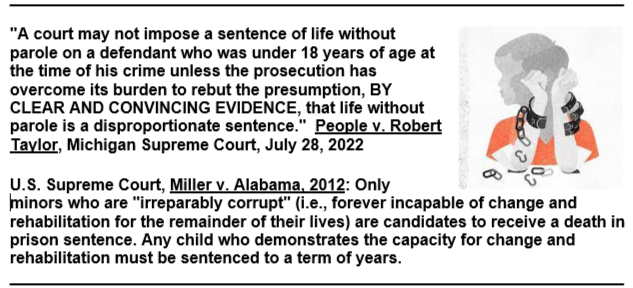

EDITOR: The article following this introduction, by juvenile lifer Efrén Paredes, Jr. first appeared in Against the Current. We are re-publishing it now because on July 27, 2023 the Michigan Court of Appeals upheld Berrien County Judge Charles LaSata’s second ruling condemning Efrén Paredes, Jr. to death in prison.
The COA originally remanded the case to LaSata with the understanding that he would re-sentence Paredes to a term of years under U.S. Supreme Court rulings in Miller v. Alabama and Montgomery v. Louisiana, as then recommended by the prosecutor’s office. Michael Sepic, the original prosecutor on the case, retained control of the case despite his retirement in 2021. He reportedly promised the victim’s family during the first trial that Paredes would never see the light of day again.
 The COA ruling affirming death in prison for Paredes is only four pages. It alleges Paredes belonged to a “security threat group” in prison and that he “impregnated” his wife with their child on prison premises.
The COA ruling affirming death in prison for Paredes is only four pages. It alleges Paredes belonged to a “security threat group” in prison and that he “impregnated” his wife with their child on prison premises.
It reiterates the original trial allegations against Paredes, that he was a gang leader and the actual shooter of the store-owner who was killed.
Paredes, his attorneys and supporters like Paul Condino, former chief investigative advisor for Northwestern University Law School’s Center on Wrongful Convictions have long disputed those charges.
“There is not one shred of credible evidence to suggest that Efren was involved in the murder,” Condino said. “No weapon, no eyewitnesses, no physical evidence, no motive, no prior conduct to suggest that a 15-year-old student athlete, and honor roll student with zero criminal background, would have planned, participated in or committed this murder. The community and jury were sold a bill of goods based on the words of drug dealers and thieves.”
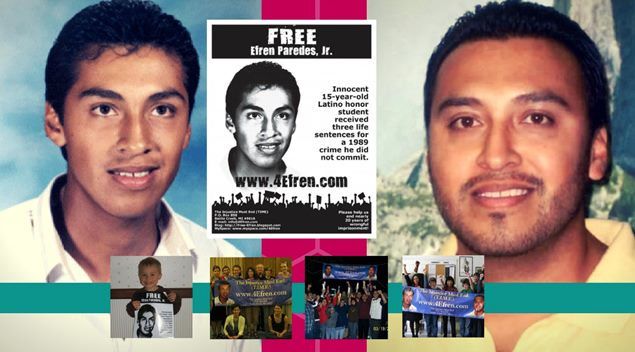
The COA ruling has stunned thousands of Paredes’ supporters across the U.S. Paredes was 15 years old at the time of his original conviction and sentence and has had a long and illustrious history in prison as an advocate-activist and scholar.
Paredes’ attorney Stuart Friedman told VOD he is appealing the ruling to the Michigan Supreme Court and will provide more details once his appellate brief is completed in the coming weeks.
VOD will publish a story with analysis of the July 23 ruling and its implications at that time. The ruling is at http://voiceofdetroit.net/wp-content/uploads/Efren-Parades-COA-affirming-LWOP-7-27-23.pdf.
Michigan Appellate Courts Curb Death in Prison Sentences for Minors – Against the Current.
BY EFRÉN PAREDES, JR.
(Efrén Paredes, Jr. is Co-Chair of the Michigan Poor People’s Campaign. He is also a social justice changemaker who works at the intersection of decarceration, racial justice, and conflict resolution. You can read more of his writings or listen to his interviews by visiting http://fb.com/Free.Efren.)

Rally in Lansing, Michigan 2021
A decade after the U.S. Supreme Court banned mandatory life without parole (LWOP) sentences for justice-involved children under age 18 (“juvenile lifers”), Michigan appellate courts are course-correcting years of arbitrary sentencing outcomes which have been an affront to the rule of law.
LWOP sentences are often referred to as “death in prison” or “death by incarceration” sentences because a person who receives the extreme punishment is condemned to die in prison unless her/his sentence is commuted by the Governor which is unlikely to occur in most cases.
In multiple rulings during December 2022 the Michigan Court of Appeals and Michigan Supreme Court (MSC) vacated the LWOP sentences of ten juvenile lifers and remanded them back to the trial court for resentencing.
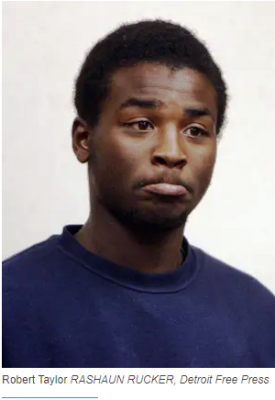
Juvenile lifer Robert Taylor
The MSC rulings stated in relevant part: “A court may not impose a sentence of life without parole on a defendant who was under 18 years of age at the time of his crime unless the prosecution has overcome its burden to rebut the presumption, BY CLEAR AND CONVINCING EVIDENCE, that life without parole is a disproportionate sentence.” (emphasis in original text)
The MSC’s “clear and convincing evidence” statement is a reference to a precedent-setting decision it issued in the summer of 2022 in the case of People v. Robert Taylor. [1] ______________________________![]() Taylor was re-sentenced to LWOP a third time in March, 2023 because the Supreme Court remanded his case to the COA for determination on a separate issue, that of “aiding and abetting.” The COA ruled that a juvenile could be sentenced to LWOP on that issue, and sent it back to the trial court for re-sentencing. But it left open several issues saying only the Supreme Court could decide on them. _____________________________________________________________
Taylor was re-sentenced to LWOP a third time in March, 2023 because the Supreme Court remanded his case to the COA for determination on a separate issue, that of “aiding and abetting.” The COA ruled that a juvenile could be sentenced to LWOP on that issue, and sent it back to the trial court for re-sentencing. But it left open several issues saying only the Supreme Court could decide on them. _____________________________________________________________
The number of minors resentenced to LWOP in Michigan continues to decline as trial court judges overwhelmingly reject death in prison sentences. It is also declining because the small percentage of extreme sentences that are imposed by sentencing bodies are being vacated by appellate courts.
U.S. SUPREME COURT STEPS IN
In 2012 the U.S. Supreme Court banned mandatory LWOP sentences for minors under age 18 in its landmark Miller v. Alabama ruling. [2] The court reached its conclusion based on a robust body of social sciences and neurodevelopmental research which confirm that the human brain doesn’t fully develop until the mid-20’s and people’s character and identity formation continues to change throughout their lives.
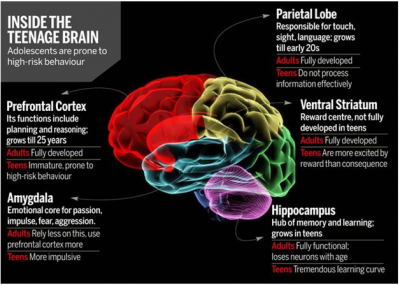 Researchers have found that the areas of the adolescent brain that are underdeveloped are responsible for impulse control, problem solving, resisting peer-pressure, and conducting a cost-benefit analysis of risky behavior.
Researchers have found that the areas of the adolescent brain that are underdeveloped are responsible for impulse control, problem solving, resisting peer-pressure, and conducting a cost-benefit analysis of risky behavior.
Teenagers focus on short-term consequences. They also lack the cognitive and psychosocial development to accurately predict future outcomes. Individually or collectively these traits can lead to engaging in criminal misdeeds.
In reaching its decision the U.S. Supreme Court replaced the mandatory component of sentencing children convicted of homicide crimes with a discretionary option. The change provides sentencing bodies discretion to impose term-of-year or LWOP sentences.
Term-of-year sentences allow people to be released one day if they are able to survive decades of incarceration.
The U.S. Supreme Court made it emphatically clear, however, that only minors who are “irreparably corrupt” (i.e., forever incapable of change and rehabilitation for the remainder of their lives) are candidates to receive a death in prison sentence. Any child who demonstrates the capacity for change and rehabilitation must be sentenced to a term of years.
It would be four more years before the U.S. Supreme Court would make the Miller ruling retroactive in 2016 in the case of Montgomery v. Louisiana, [3] making it applicable to all cases including those which had previously exhausted their direct appeals.
WHAT THE NUMBERS SHOW
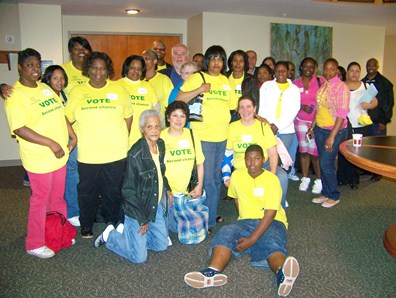
Families and supporters of juvenile lifers flooded the State Capitol to lobby for bills that would have made them eligible for parole even before the US Supreme Court ruling in Miller v. Alabama in 2012. Photo May 6, 2009. Wayne Co. Pros. Kym Worthy and the prosecutors from Oakland and Berrien Counties spoke against the bills, which were defeated.
Since 2016 when juvenile lifer resentencing hearings began, 287 of the total 363 Michigan juvenile lifers have received term-of-year sentences. The minimum sentence allowed ranges from a substantial 25 to 40 years. The maximum portion of the sentence is a mandatory 60 years (e.g., 25-60 years, 30-60 years, 40-60 years, etc.).
The average term-of-year sentence received has been 32.5 years and the average person has been nearly 45-years-old at the time of resentencing.
Seventy-six people still await having their LWOP sentences reviewed for resentencing consideration. There are also currently 11 remaining Michigan juvenile lifers originally sentenced to death in prison who received the sentence for a second time after their cases were considered for resentencing.
The latter individuals await an appeals court to vacate their sentences so they can be properly resentenced for a third time to a term of years.
Despite 79% of Michigan juvenile lifers who committed crimes between ages 14-17 being resentenced thus far Michigan has the shameful distinction of leading the nation as the state with the highest number of minors sentenced to LWOP.
A VIEW FROM THE INSIDE
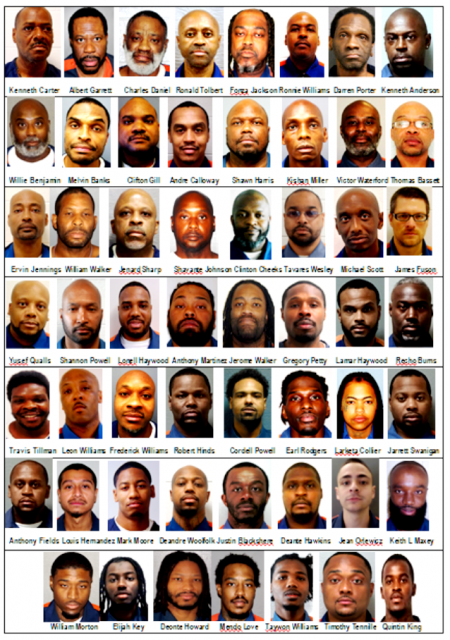
JUVENILE LIFERS FROM WAYNE CO. STILL HELD IN 2021. VOD IS FOLLOWING UP ON THEIR STATUS. Wayne Co. Pros. Kym Worthy refused to recommend re-sentencings to terms of years for all.
As a soon to be 50-year-old juvenile lifer who has been incarcerated in Michigan since age 15 I’ve observed the enormous capacity for transformative change and rehabilitation incarcerated people possess. I know this not only through the prism of my own lived experiences as a husband and parent, but also through my personal interactions with thousands of other incarcerated people during the nearly 34 years I have spent behind bars.
Whether it’s successfully completing self-help or rehabilitative educational, vocational, or counseling programs during their time caged in carceral exile, juvenile lifers are constantly evolving. Some more than others, and some quicker than others.
During times they struggle with their transformation it often occurs when they lack support, connection with the outside world, and/or struggle to find purpose and hope amid recurring thoughts of being condemned to breathe their last gasp of air alone behind prison walls.
Some of their beliefs have been reinforced by the painful reality that since 2012 seven juvenile lifers have died in prison while awaiting the opportunity to be released. Two of them died after being resentenced to a term of years.
 Sentencing minors to death in prison is divorced from the reality that people can and do change. No adult is the same person they were in their teenage years. According to Mihailis E. Diamantis, author of the article, “Limiting Identity in Criminal Law:”
Sentencing minors to death in prison is divorced from the reality that people can and do change. No adult is the same person they were in their teenage years. According to Mihailis E. Diamantis, author of the article, “Limiting Identity in Criminal Law:”
“Identity development never ceases: the persons adolescents will become are not the persons they will remain. The process of self-identification and redefinition lasts a lifetime.” [4]
I’ve come to learn it’s important not to define people by a single event in the spectrum of life — neither by their worst mistake nor greatest success. Human beings are a culmination of their lived experiences. It makes more sense to measure people by the totality of their choices and experiences rather than a snapshot in time.
THE LIVES OF FREED JUVENILE LIFERS: 1% RECIDIVISM RATE
Five months ago the MSC stated, “A steady line of precedent from the Supreme Court could not be clearer — persons under 18, as a group, are less culpable than adults, more prone to outside influence, and more likely to be rehabilitated. For these reasons and others, juveniles are ‘less deserving of the most severe punishments.'” [5]
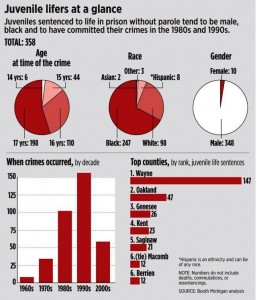
Chart shows races of juvenile lifers in Michigan, counties where they were convicted. Wayne Co. far outstripped the rest.
When we examine the lives of the 172 juvenile lifers who have been released from prison their recidivism rate ranks the lowest of any demographic released from Michigan prison at less than 1%. The national recidivism rate for all people released from prison is 68%. [6]
According to Preston Shipp, Senior Policy Counsel at the Campaign for Fair Sentencing of Youth, “Nationwide, 935 formerly life-sentenced children and counting have been released back to society based on changes in the law.” He adds, “They are now home, thriving, raising families, working, mentoring at-risk youth, and finding creative, imaginative ways to serve their communities.”
This can be attributed not only to their capacity for change and rehabilitation, but also to the fact that in each instance it is the first time they will be afforded the opportunity to experience freedom for the first time in their adult lives.
They acknowledge the mercy bestowed upon them. They also bear the emotional and psychological scars of spending decades of their lives condemned to die in prison. To eschew returning to this horrific life they commit to becoming a better version of themselves by making prosocial choices and striving to become thoughtful, sound consequential thinkers.
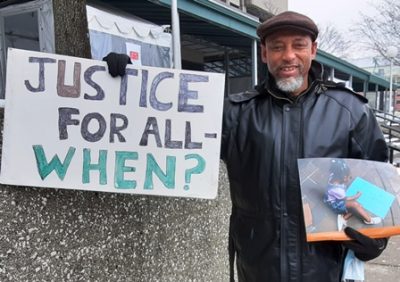
Former juvenile lifer Edward Sanders earned his B.A. in prison, then an M.S. after release. He has worked as a paralegal since then.
A 2022 report titled, “White Paper on the Science of Late Adolescence: A Guide for Judges, Attorneys, and Policy Makers,” found “[i]t is currently not possible to reliably predict an individual adolescent’s future developmental trajectory based upon current presentation and past history.” Additionally, “It is also currently scientifically impossible to reliably predict how much or how quickly an individual will change with age based on their presumed brain development, history, or current behavioral profiles.” [7]
Juvenile lifers have repeatedly proven this research to be true. They have demonstrated they can change and do better if afforded the opportunity, even when sentencing courts originally misjudge them and make erroneous predictions that they will be forever irredeemable.
DISPARATE CONSEQUENCES OF EXTREME YOUTH SENTENCES
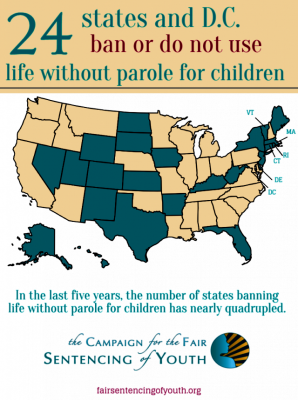 Twenty-five states across the country and the District of Columbia have banned death in prison sentences for justice-involved children. Nine other states have no one serving the sentence who was convicted as a minor. [8] This leaves Michigan among the 16 outliers who still impose the sentences.
Twenty-five states across the country and the District of Columbia have banned death in prison sentences for justice-involved children. Nine other states have no one serving the sentence who was convicted as a minor. [8] This leaves Michigan among the 16 outliers who still impose the sentences.
Glaring racial sentencing disparities also exist between children of color and their white counterparts.
Prior to the landmark 2012 U.S. Supreme Court ruling banning mandatory LWOP sentences for minors, though children of color comprised 27% of the child population in Michigan they were 71% of the children sentenced to death-by-incarceration. [9] Since that time eleven of the new juvenile lifers sentenced to LWOP in Michigan — or 73% — have been children of color, reflecting no regard for decreasing racial sentencing disparities.
As a directly impacted person of color I know this all too well. As of December 29, 2022 I am the only Latino of the 11 remaining juvenile lifers resentenced to death in prison in Michigan who awaits being resentenced to a term of years.
 Discriminatory sentences for similarly situated people violate the Equal Protection Clauses of the Michigan and U.S. Constitutions [10] and offend internationally recognized human rights treaties. Racialized harms committed by the criminal legal system against people of color are also largely responsible for fueling the scourge of mass incarceration.
Discriminatory sentences for similarly situated people violate the Equal Protection Clauses of the Michigan and U.S. Constitutions [10] and offend internationally recognized human rights treaties. Racialized harms committed by the criminal legal system against people of color are also largely responsible for fueling the scourge of mass incarceration.
A two-tiered legal system produces inequitable results by othering members of out-groups from marginalized and underserved communities.
“The only surefire way to eliminate racial bias and arbitrariness in [Miller v. Alabama] sentencing is for states to … eliminate life without parole for children[,]” according to Kathryn E. Miller, Clinical Assistant Professor of Law at Cardozo Law School. [11]
RECOGNIZING CHILDREN AREN’T ADULTS
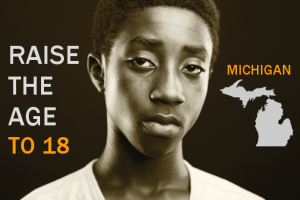 On July 28, 2022 the MSC issued a ruling in People v. Parks, Docket No. 162086, which raised the age of minors entitled to the protections afforded in Miller v. Alabama to include persons 18 years of age. The high court is also asking the Michigan Court of Appeals to consider whether the state should raise the age to include late-adolescents up to 21-years-old which is widely supported by evolving brain science. [12]
On July 28, 2022 the MSC issued a ruling in People v. Parks, Docket No. 162086, which raised the age of minors entitled to the protections afforded in Miller v. Alabama to include persons 18 years of age. The high court is also asking the Michigan Court of Appeals to consider whether the state should raise the age to include late-adolescents up to 21-years-old which is widely supported by evolving brain science. [12]
The recent move by the MSC is an indicator that the high court is breaking away from decades-old beliefs about human evolution and making decisions informed by a dearth of evidence-based, twenty-first century scientific results.
Children receive a panoply of legal protections because society widely recognizes they are too developmentally immature to make the same responsible decisions as adults (e.g., purchase alcohol, vote, join the military, etc.). Their protections shouldn’t abruptly end when they make irresponsible mistakes.
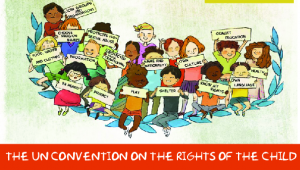
THE U.S. IS THE ONLY COUNTRY IN THE WORLD THAT SENTENCES CHILDREN TO DEATH IN PRISON.
It is a universally recognized unmistakable fact that children are not adults. They are also a product of their environment they are typically unable to extricate themselves from no matter how pernicious it may be to them.
In the interest of public safety children rightly deserve to be held accountable for the harm they commit. However, the penalty should be proportional and developmentally aligned to their diminished culpability and still unformed character.
The criminal legal system should never treat minors as though they are miniature adults nor should children be subjected to the harshest punishments adult offenders are eligible to receive.
FORWARD-THINKING CONSIDERATIONS
Weaponizing public fear to demonize children and justify harsh sentencing policies has proven to be an ineffective approach to deter people from committing crime. This is especially true as it relates to young people.
Society should invest more money and resources dealing with the root of the crime problem than on its symptoms if we are serious about preventing harm. Investments in education and community-based programs such as counseling, mentorships, and after-school programs provide far greater preventive measures against crime the earlier they are made available than the threat of warehousing bodies in cages.

President Barack Obama speaking on Trayvon Martin case.
In a 2017 Harvard Law Review article President Barack Obama wrote:
“How we treat citizens who make mistakes (even serious mistakes), pay their debt to society, and deserve a second chance reflects who we are as a people and reveals a lot about our character and commitment to our founding principles. … [It] speaks to who we are as a society and is a statement about our values — about our dedication to fairness, equality, and justice, and about how to protect our families and communities from harm, heal after loss and trauma, and lift back up those among us who have earned a chance at redemption.” [13]
We would do well to meet this moment by utilizing the wisdom of President Obama as a torch to lead us out of a benighted era of extreme sentencing policies against justice-involved children into an enlightened era that recognizes “youth matters in sentencing.” [14]
Archaic policies that eternally banish people to cages for youthful mistakes or bad behavior are antithetical to decency and human dignity. Promoting justice for minors means choosing life-affirming options like healing and restoration over destructive forces like hate and vengeance.

Kuntrell Jackson and Evan Miller, the plaintiffs in Miller v. Alabama, were each 14 at the time of conviction. Paredes was 15.
The U.S. Supreme Court made it clear that only minors who demonstrate they are irreparably corrupt (i.e., forever incapable of change and rehabilitation) are candidates to receive death in prison sentences. However, asking sentencing judges to predict who is forever incapable of change and rehabilitation is an impossible task, as stated earlier.
Rather than ask sentencing bodies to engage in conjecture that will yield capricious results I invite the Michigan legislature to abolish death behind bars sentences for justice-involved children and join the majority of U.S. states which have replaced it with term-of-year sentencing options.
This humane policy change will provide minors with a meaningful, realistic, and achievable opportunity for release consideration later in their adult lives based on demonstrated change and rehabilitation. It’s a common sense approach to justice for children that acknowledges all stakeholders in the legal process by creating space for both accountability and the possibility of redemption.
Most importantly it promotes equity, a hallmark of our criminal legal system we should strive to uphold each day.
ARTICLE NOTES AND RELATED ARTICLES BELOW
[1] – People v. Robert Taylor, MSC Docket No. 154994, decided July 28, 2022.
[2] – Miller v. Alabama, 567 U.S. 460 (2012).
[3] – Montgomery v. Louisiana, 577 U.S. 190 (2016).
[4] – Mihailis E. Diamantis, “Limiting Identity in Criminal Law,” 60 B.C. L. Rev. 2011, 2077 (2019).
[5] – People v. Robert Taylor, supra note 1, slip op at 17.
[6] – J.J. Prescott, Benjamin Pyle & Sonja Starr, “Understanding Violent-Crime Recidivism,” 95 Notre Dame L. Rev. 1643, 1667 (2020).
[7] – Catherine Insel & Stephanie Tabashneck, “White Paper on the Science of Late Adolescence: A Guide for Judges, Attorneys, and Policy Makers” 39, Ctr. for Law, Brain, & Behavior (2022), https://bit.ly/3JLArOR.
[8] – Josh Rovner, “Juvenile Life Without Parole: An Overview,” The Sentencing Project, (May 24, 2021), https://www.sentencingproject.org/…/juvenile-life…/.
[9] – Connie de la Vega & Michelle Leighton, “Sentencing Our Children to Die in Prison: Global Law and Practice,” 42 U.S.F. L. Rev. 983, 994 (2008).
[10] – Avery Katz, “‘Black First, Children Second’: Why Juvenile Life Without Parole Violates the Equal Protection Clause,” 106 Minn. L. Rev. 2693, 2733-2737 (2022).
[11] – Kathryn E. Miller, “Resurrecting Arbitrariness,” 107 Cornell L. Rev. 1319, 1357 (2022).
[12] – Insel & Tabashneck , supra note 7, at 7.
[13] – Barack Obama, “The President’s Role in Advancing Criminal Justice Reform,” 130 Harv. L. Rev. 811, 812, 866 (2017).
[14] – Jones v. Mississippi, 141 S. Ct. 1307, 1314-16 (2020).
About his case, Paredes wrote VOD months ago, “As for my own case, I am still awaiting an answer from the Michigan Court of Appeals (MCOA). My prosecutor filed a brief with the MCOA conceding that my sentence must be vacated and telling the court to remand me back to the trial court. Despite the prosecutor’s concession I have been waiting nine months for a ruling.
I am thinking in the next couple months I’ll receive a ruling from the court. I’m hopeful things get resolved and I’m able to put this behind me real soon. If things go as hoped for I could be released by June or July. Fingers crossed. I continue to remain focused and busy writing about my experience in hopes that we can change the policies keeping people caged for harm they were convicted of decades ago during their childhood. Bills seeking to end extreme LWOP sentences for minors in Michigan are expected to be introduced in the coming week.”
RELATED STORIES TO COME




